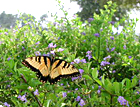Invasive species to avoid or eliminate in your yard & neighborhood: |
|||
 |
Camphor Tree Cinnamomum camphora |
 |
Mexican Petunia Ruellia brittoniana |
 |
Arrowhead Vine Syngonium podophyllum |
 |
Creeping Oxeye Wedelia trilobata |
 |
Chinese Tallow Sapium sebiferum |
|
Tuberous Sword Fern |
|
Wild Taro |
|
Brazilian Pepper |
Invasive and Non-Native Plant Species
What is an invasive non-native plant?
An invasive non-native plant species is an introduced species that has been shown to displace the native vegetation by out-competing native species. Without the factors that normally keep them under control in their native homes, invasive vegetation species overwhelm and displace existing vegetation to form dense, single-species stands that dominate and displace the natural community.
Prevent the spread of invasive non-native plants
By choosing to plant a garden with native plants, you will prevent the spread of invasive plants from your yard to other natural areas. At the same time, you conserve water, energy, time and money, as well as reduce or eliminate the need for harmful pesticides and herbicides. There are a wide variety of native plants and landscaping designs to choose from in creating the Florida yard that is the most pleasing to you.
Be on the lookout!
The below non-native plants are sometimes found in nurseries and landscapes in Central Florida. Be sure to look for these weedy and invasive species – inform your neighbors if you see these plants within the neighborhood. If you spot these plants at Harmony, please contact folks at Harmony Conservation Cafe
Why should you care?*
Once invasive plants take over our native plants, the result is:
- Florida’s natural biodiversity is destroyed.
- Our native plants can eventually become permanently eliminated.
- The animals that use those native plants cannot make use of the non-native ones.
- Aquatic invasive plants can harm fish habitats.
- Boating, swimming, hiking and other uses can be eliminated from areas with invasive plants because they clog up areas.
- Costs billions of dollars to eradicate.
*This list has been adapted from http://plants.ifas.ufl.edu/node/673.




